Robyn Roth: a Legacy of Care
Robyn Roth, PT, MPA, comes from a show business background. Her mother was an opera singer and her father was a conductor and bandleader who worked in film and television, but she charted her own path and found a way to combine her love of animals with her passion for physical therapy. She is owner and operator of Sugarland Ranch, an animal rescue that also provides boarding services. “Those are my rescue dogs barking,” she said as we signed on to Zoom for the interview. “They’re going to participate, I guess.”
Tell us a little bit about yourself and your background.
I’ve been a physical therapist since 1971.
Originally, I’m from Pennsylvania, but after I graduated from high school, I made my way to California and eventually to physical therapy school at Long Beach State. I was in California prior to moving to Nevada and building our 52-acre ranch.
After getting my physical therapy degree I got a master’s degree in public administration.
You’ve had a long and interesting career. Can you tell us about some lessons that you learned along the way?
I was probably one of the earliest PTs in leadership positions in an area where nurses dominate. As I entered the fields of home health and hospice care, I became chief executive officer of a visiting nurse association.
I was also Vice President for VHA Consulting, where I oversaw a division. At that time, it was called Voluntary Hospitals of America, which was a group of the largest non profit hospital systems in the US at that time.
I think what physical therapy allowed me to do was to take those leadership positions. Now, it’s very commonplace, but back in the day it wasn’t so. I consider myself an innovator in that way. And more recently, in veterinary medicine: a small group of us in the 1990s got together and saw that was not a thing. We made it a thing.

Robyn and her patient at work in the pool
What motivated you and your husband, Mack, to include the Foundation in some of your estate plans?
My husband supports me; he’s very proud of what I’ve done. It’s great work that the Foundation does, allowing research to be done. That’s why I believe the Foundation has played a huge part in the advancement of physical therapy. All you have to do is go to a conference and see all the advancements and know the Foundation has played a major part. So obviously, that was a natural choice for us.
When you do legacy planning, you really must consider: Is the organization going to be there? Is your money going to be spent wisely? And the answer to that is “absolutely,” with the Foundation.
Your planned gift will create an endowment fund. Can you tell us the purpose of the endowment and what impact you hope it will have on the profession?
I’ve always been interested in what I call the “public health space,” and when COVID-19 hit, our field was hit badly. I thought about it, and I thought about what might be needed.
What the Foundation could do with those funds is advancements in research, support folks coming from diverse backgrounds who want to become physical therapists, and who want to spend their time in rural areas to help in public health efforts. If there should be another pandemic we should be prepared, and the board should have some leeway in applying the funds to help the profession during a very trying time.
If you were meeting someone for the first time, how would you describe the Foundation?
I would ask, “What experiences have you had with a physical therapist?” I would say, “When I started … we were still doing hot packs ultrasound massage.” I would tell that person, “That’s probably not what you got when you visited your physical therapist, is it?” They’d probably look at me like I had two heads, because it’s doubtful that we do that anymore.
I would explain that the Foundation is the research arm providing scholarship and research opportunities to allow the advancement of the field. It’s very important that we do that.
What advice would you have for folks who are still in in the process of estate planning?
You have to research organizations. Many worthy organizations are out there where you could apply funding to a variety of subjects that you might be interested in. But how stable are those organizations? Are they going to be around 100 years from now? How have they run their organizations?
It just took a lot of time, and it had to be very thoughtful. It takes far more time than you think; you make a lot of changes; you must be patient with the process. It’s not a matter of just filling out paperwork. You have to be thoughtful about it because you’re basically trying to direct traffic from the grave.
But we are very comfortable with the beneficiary of our estate being the Foundation, because of the stability, the way the Foundation uses the money, and their accountability. Our legal firm was impressed with the Foundation’s process of going through step by step, making sure the purpose was clear, even thinking through the purpose in public health.
Where does your love for animals come from?
I grew up on the East Coast, but my father bought a ranch and I remember pictures of my mother with deer sitting on her lap. We had Great Danes, big dogs. I rode horses. My heart of hearts is with dogs, and I volunteered with big cats, and that was always my other interest.
When you treat animals it’s very relatable. It reminds me of treating pediatric patients because you have a nonverbal patient, and you have a parent who is very invested. Those pets are their children. We’ve really come a long way in that field.
Any final thoughts?
My one regret is I’m not going to be around 100 years from now to see how well we do like we’ve done the last 100 years. But I know the Foundation is going to take that up and continue the mission. I have great faith in the Foundation.

A birds-eye view of the Sugarland Ranch

STAY CONNECTED
Use this form to sign up for the Foundation for Physical Therapy Research monthly newsletter.